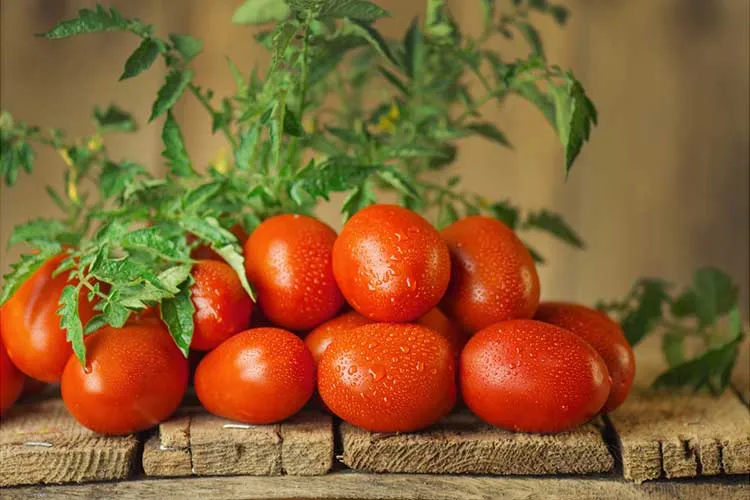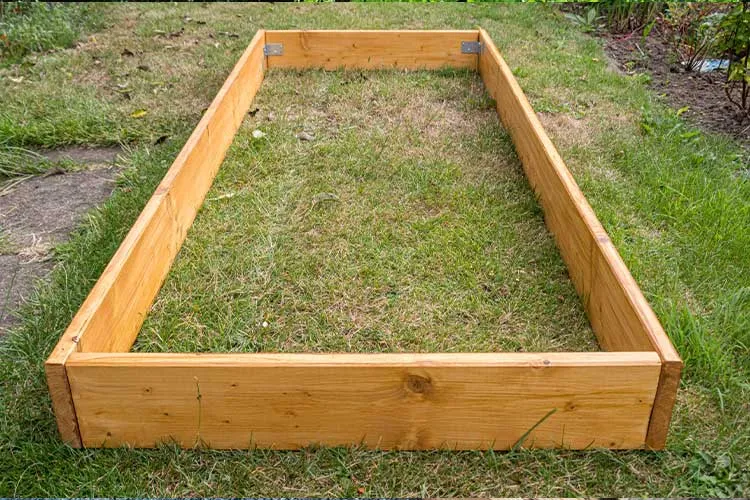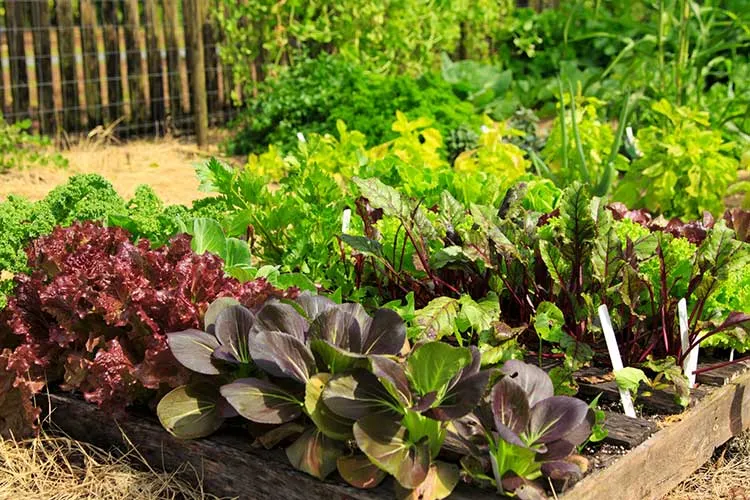Tomatoes are nutrient-hungry plants, and giving them the right care starts with understanding how to use tomato fertilizer effectively. Whether you’re growing them in-ground, in raised beds, or containers, the right type of fertilizer can make all the difference. Organic fertilizers, like compost or seaweed extract, offer a sustainable, slow-release option to improve soil health. Meanwhile, synthetic choices, such as 10-10-10 formulas, provide precise, fast-acting nutrients for immediate results.
Granular fertilizers work well for steady feeding, slowly breaking down as you water. Liquid fertilizers are perfect for a quick boost during critical stages, such as flowering. By tailoring your approach to your setup and tomato growth stage, you’ll set the foundation for a lush, productive harvest.
What Nutrients Tomatoes Need
Tomatoes thrive on a balanced mix of macronutrients and micronutrients, each vital to their development. Nitrogen, phosphorus, and potassium are the primary macronutrients tomatoes rely on for robust growth. Nitrogen supports leafy green growth, which is essential in the early stages as plants establish a strong canopy. Phosphorus promotes root development and is crucial during the seedling phase and flowering, helping the plant access water and nutrients. Potassium strengthens stems and improves fruit quality, playing a key role as fruits begin to develop and ripen.
Beyond these, tomatoes require micronutrients like calcium, magnesium, and iron in smaller amounts. Calcium helps prevent blossom end rot by supporting cell wall formation, especially during fruiting. Magnesium is essential for photosynthesis, giving leaves their vibrant green color and powering the plant’s energy production. Iron aids in enzyme function and chlorophyll synthesis, ensuring steady growth throughout the season.
These nutrients must be available at the right time to match the plant’s needs. For example, nitrogen takes priority during early growth, while flowering and fruiting require a boost in phosphorus and potassium. A well-rounded fertilization approach ensures your tomatoes get everything they need for a healthy and productive season.
Choosing the Best Tomato Fertilizer
Selecting the right fertilizer for your tomatoes starts with understanding their specific needs and your soil’s condition. Soil testing is a smart first step, revealing nutrient deficiencies that your fertilizer can address. The best tomato fertilizers typically provide a balanced or slightly adjusted N-P-K ratio to match growth stages, like higher nitrogen for early growth and increased phosphorus and potassium for flowering and fruiting.
Commercial fertilizers come in a wide variety of options tailored for tomatoes. Organic choices like composted manure, fish emulsion, or blood meal provide a natural nutrient source while improving soil health. Synthetic fertilizers, such as 10-10-10 or 5-10-10 formulas, deliver nutrients quickly for fast results. When choosing a fertilizer, look for products labeled specifically for tomatoes, as these are formulated to address the plant’s unique requirements.
Quality fertilizers should include trace elements like calcium and magnesium alongside the basic macronutrients. For their reliable results, brands like Espoma Tomato-Tone or Miracle-Gro Tomato Plant Food are popular options among gardeners.
Read the label carefully to match the product to your soil’s needs and the plant’s growth stage. For example, if your soil test shows sufficient nitrogen, a lower-N fertilizer like 5-10-10 helps avoid over-fertilizing, which can lead to excessive foliage and fewer fruits. By aligning your choice with your garden’s specific conditions, you ensure your tomatoes get exactly what they need for vibrant growth and abundant harvests.
Understanding Fertilizer Ratios
Fertilizer labels display N-P-K ratios, which represent the percentages of nitrogen (N), phosphorus (P), and potassium (K) in the product. For example, a 10-10-10 fertilizer contains 10% of each nutrient, while the rest is filler to aid application.
Understanding these ratios helps you choose the right fertilizer for your tomatoes. Early in the season, a higher nitrogen content (e.g., 10-5-5) supports leafy growth and stem strength. As flowering and fruiting begin, switch to a lower nitrogen and higher phosphorus and potassium ratio, like 5-10-10, to encourage blooms and healthy fruit development.
Matching ratios to your soil is key. If a soil test reveals adequate phosphorus, opt for a more balanced formula to prevent nutrient buildup. Testing ensures you’re giving your tomatoes exactly what they need without overloading the soil.
Types of Tomato Fertilizers
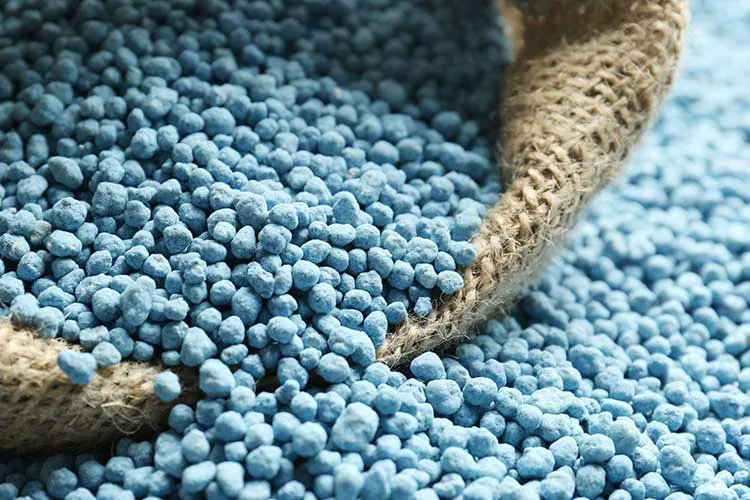
Choosing between organic and synthetic fertilizers often depends on your gardening goals and preferences. Organic fertilizers, such as compost, bone meal, or seaweed extract, improve soil health over time and slowly release nutrients. They enrich the soil ecosystem, making it ideal for gardeners looking for sustainable, long-term solutions. On the downside, organic options can be slower to show results, which may not suit gardeners needing an immediate boost.
Synthetic fertilizers, like those labeled 10-10-10 or 5-10-10, offer quick and precise nutrient delivery. They are convenient and effective for correcting nutrient deficiencies or boosting growth during key stages. However, they can deplete soil health over time if used exclusively, and improper application may risk over-fertilizing.
When considering how to use tomato fertilizer, matching the type with your growing conditions is essential. Granular fertilizers are practical for long-term feeding. Applied to the soil, they break down slowly with watering, ensuring consistent nutrient availability. These are excellent for in-ground planting, where steady growth is the goal. On the other hand, liquid fertilizers are fast-acting and ideal for addressing immediate needs, like a quick phosphorus boost during flowering. They’re also easy to use in container gardens, where nutrients may wash out more quickly.
For versatility, some gardeners combine types, using granular organic fertilizers for baseline feeding and supplementing with liquid synthetic options during critical growth stages. Choosing the right type depends on your tomatoes’ needs, whether they’re growing in containers, raised beds, or traditional garden plots.
How Much Fertilizer Do Tomatoes Need?
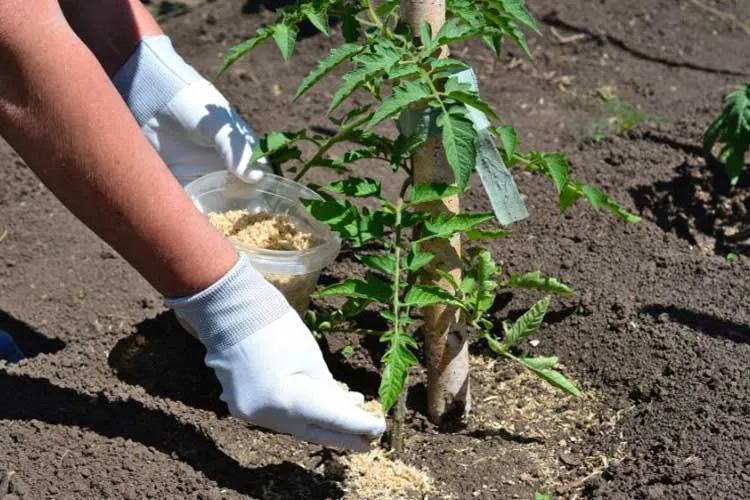
Applying the right amount of fertilizer is crucial for tomato health. Too much can lead to lush foliage with little fruit, while too little leaves the plant struggling to grow. A balanced approach ensures steady, healthy development.
For in-ground tomatoes, mix a general-purpose fertilizer like 5-10-10 into the soil at planting time, using about 2 tablespoons per plant. If using organic options, apply compost or aged manure generously to provide a slow, steady nutrient release. After plants establish, feed them every 2–4 weeks, adjusting the amount based on growth and fruit production.
Container-grown tomatoes need more frequent feeding, as nutrients wash out quickly with watering. Use a water-soluble fertilizer diluted to half strength every 7–10 days, or add a time-release granular fertilizer to the potting mix at planting.
Be cautious of over-fertilizing, especially with nitrogen-heavy formulas, which can result in excessive leaf growth at the expense of flowers and fruit. On the other hand, under-fertilizing can lead to stunted growth and poor yields. Regular observation helps you fine-tune application rates—adjust if leaves yellow, growth slows, or fruit production declines.
When and How to Fertilize Your Tomato Plants
Timing your fertilizer applications ensures your tomatoes get nutrients when they need them most. Start by preparing the soil before planting. Mix a balanced fertilizer, like 5-10-10, or compost into the planting site to provide a nutrient-rich foundation. This step supports strong roots and healthy initial growth.
At transplanting, add a phosphorus-rich fertilizer to the hole to promote root establishment. Avoid direct contact with roots to prevent burning—place the fertilizer a couple of inches away. Once the plants settle and begin growing, fertilize again about 3–4 weeks after planting to maintain healthy development.
As flowering starts, switch to a lower-nitrogen and higher-phosphorus and potassium formula, such as 5-10-10 or 4-6-8. Apply the fertilizer around the base of the plant, avoiding contact with leaves and stems. Water the area thoroughly to help the nutrients seep into the soil. Repeat this process every 2–4 weeks through the fruiting stage.
For consistent results, monitor plant health throughout the season. If growth slows or leaves yellow, a liquid feed can provide an immediate boost. Conversely, if plants become overly leafy with minimal flowers, reduce nitrogen in your next application.
Timing is just as important in container gardens. Begin feeding a week or two after transplanting, using a diluted liquid fertilizer every 7–10 days. Regularly adjust the schedule based on plant response, ensuring your tomatoes thrive with just the right amount of care.
Techniques for Fertilizing Tomatoes
Different fertilizing techniques help ensure your tomatoes get the nutrients they need in the most efficient way. Choosing the right method often depends on whether you’re growing tomatoes in-ground, in raised beds, or in containers.
Side-Dressing: This method involves applying fertilizer alongside your tomato plants during the growing season. Scatter granular fertilizer a few inches away from the base of the plant, forming a shallow trench or circle. Cover lightly with soil and water thoroughly. Side-dressing is ideal for delivering nutrients steadily to in-ground or raised bed tomatoes, especially during flowering and fruiting stages.
Foliar Feeding: Foliar sprays, made with liquid fertilizers, are applied directly to the leaves. This method provides a quick nutrient boost, particularly for correcting deficiencies like yellowing from a lack of magnesium or iron. Use a fine mist sprayer and apply early in the morning or late in the evening to avoid leaf burn. While effective, foliar feeding should supplement—not replace—regular soil fertilization.
Drip Irrigation: Combining drip irrigation with liquid fertilizers ensures consistent nutrient delivery to the root zone. This technique works well in both gardens and containers, preventing overwatering while efficiently feeding plants. It’s especially helpful for gardeners dealing with sandy soils or areas prone to nutrient runoff.
Container Gardening: Tomatoes in pots often need more frequent feeding due to faster nutrient depletion. Use water-soluble fertilizers diluted to half strength for every watering or a slow-release granular fertilizer mixed into the potting soil at planting. Adjust feeding frequency based on plant size and stage of growth.
Experimenting with these techniques allows you to tailor your approach to your specific setup, ensuring that your tomatoes thrive regardless of where they’re planted.
Using Water-Soluble Fertilizer
Water-soluble fertilizers are a convenient and effective way to give your tomato plants a quick nutrient boost. These fertilizers dissolve easily in water, delivering nutrients directly to the roots and leaves for rapid absorption. They’re especially useful for container gardens or when plants show signs of nutrient deficiencies.
To use, mix the fertilizer according to the package instructions, typically around 1–2 tablespoons per gallon of water. Avoid over-concentrating the solution, as this can damage plants. Apply the solution during your regular watering schedule, typically every 7–14 days. For young plants, a half-strength mixture is often sufficient to prevent over-fertilization.
When applying, water the base of the plant to focus nutrients where they’re needed most. For foliar feeding, use a fine mist to spray leaves, ensuring even coverage without soaking. Morning applications are best to allow leaves to dry and minimize disease risk.
With consistent use, water-soluble fertilizers can help sustain healthy growth, vibrant foliage, and abundant fruiting throughout the season

